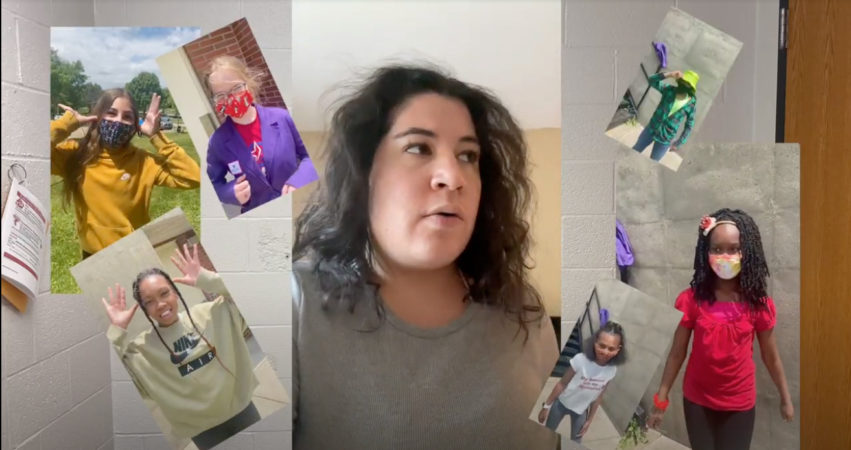
At Carrithers Middle School in Louisville, Kentucky, Director of Bands Adam Bullock said he struggled to decide what direction to take the band program when school buildings first closed due to the COVID-19 pandemic, but he found ways to keep students engaged.
“During class, I varied our activities between music rehearsal and team-building games so that we could change up the routine of practicing with a mix of social/emotional activities,” he said. “I found this to be the best way for the students to build connections and stay engaged in our rehearsals.”
While school was fully remote and band rehearsals were virtual, Bullock’s class utilized Google Meet breakout rooms to group students by instrument so they could continue to collaborate. When the hybrid schedule began, with students attending school in-person two days a week based on their last names, Bullock said rehearsals functioned “as normal as possible,” with reduced class sizes and longer class periods allowing students to receive more personalized interventions.
The class culminated in an innovative virtual band concert in which students individually recorded their performances for Bullock to edit together seamlessly. Bullock hosted private lessons daily via Google Meet to assist students who were struggling with specific phrases. The final recording was a compilation of both video and audio recordings submitted by each of Bullock’s 49 students using the Voice Memos and Camera apps on their VILS iPads and edited together using GarageBand and iMovie.
Covid has put many obstacles in the way for the performing arts. However, the Carrithers 7th/8th grade band worked vigorously to complete a virtual concert. I am so proud of them and their hard work! #BandFam 💙💛🎵 @ms_wolters @dpvils @ChrisBradyKY @mdfw08 @JCPSMiddleEA @JCPSKY pic.twitter.com/lgeCVGZvx4
— Carrithers Middle School Band (@carrithers_band) May 3, 2021
“The students put in a lot of time and effort mastering their individual parts so they could contribute to a high-quality recorded performance,” he said. “Editing the video was a huge task, but it was really satisfying to see it all take shape!”
Across town at Grace James Academy of Excellence, students were busy with virtual rehearsals for their end-of-year performance of the musical “Annie.” The students rehearsed a different scene each practice by reading through the script and practicing blocking before working on the choreography and music. After practice, the students recorded their parts and uploaded them to Google Classroom for director Dani Delvescovo to edit together.
Most of the scenes were recorded in this way; however, others were shot in school with students who opted to attend in-person. As with Bullock’s band performance, Delvescovo said the biggest challenge was practicing the songs during rehearsals because the lag made it hard to sing together.
“I wrote the script to fit with a virtual environment so I can edit all their clips together for the show,” Delvescovo said. “This has really helped the girls grow as actresses because they need to react and be in character when there is not someone for them to play off of and say their lines to.”
Performing arts were not the only form of hands-on arts that were forced to make adjustments during the pandemic. At Catalina Ventura School in Phoenix, Arizona, art teacher Terri Mickelson struggled at first to figure out how students could continue creating artwork if they did not have the necessary supplies at home.
“I am a Teaching for Artistic Behaviors (TAB) art teacher, which means that the child is the artist and the art room—or home—is their studio,” she explained. “In a TAB classroom, the artist decides what medium to create with. Last year, many students only had pencils, paper, and their iPad at home, and we adapted. We looked at items we could use that most of us had at home, even creating paint out of blueberries, coffee, tea, and cinnamon candy.”
Mickelson also taught her students how to use apps on their VILS iPads like Google Draw and Sketchbook when they did not have supplies. In addition, they looked at photography as an art form and talked about taking good photos of their artwork.
Typically Mickelson shows her students’ artwork at the school’s spring festival, but last year she created a virtual art show to showcase what her students had created during a year of distance and hybrid learning. It was a yearlong project that began by saving screenshots of artwork in September.
As all three schools proved, the show must go on, and the teachers all credited the technology and access provided by the VILS program with allowing it to happen.
“VILS has granted me and my students the opportunity to continue making music together,” Bullock said. “It may have looked different, but VILS made it possible for my band students, virtual and in-person, to be a part of and create something together. VILS has saved my band program!”
Learn more about the Verizon Innovative Learning Schools initiative at verizon.digitalpromise.org.